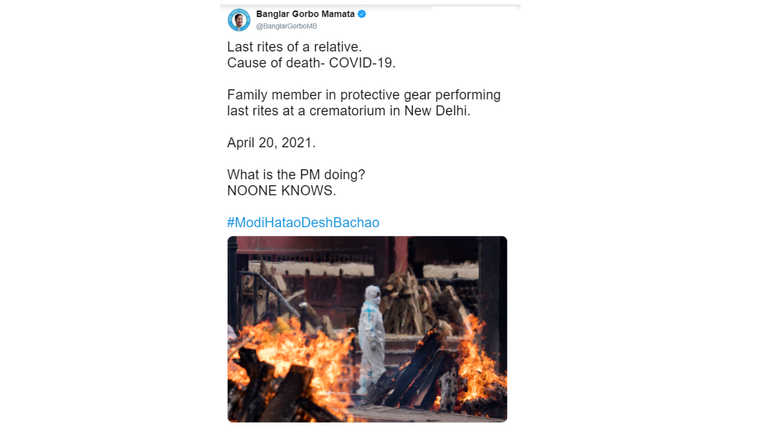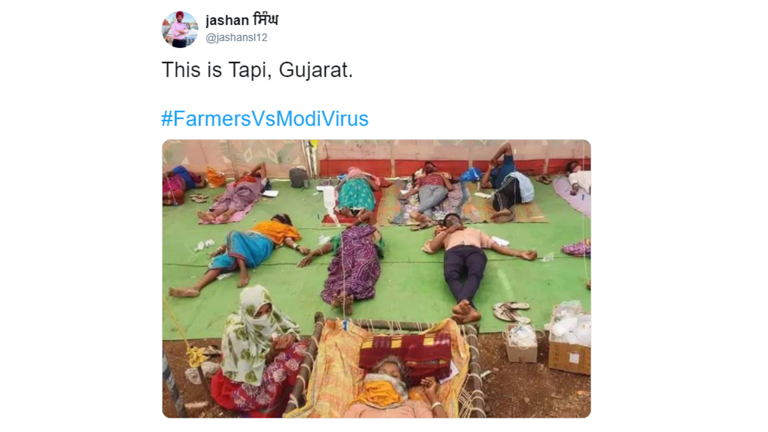Home » World News »
India’s COVID crisis: The government ordered some posts to be removed from social media – what did they say?
The Indian government is fighting a battle in two fronts.
While authorities desperately seek to contain the situation in overwhelmed hospitals, the government is coming under attack on social media over how it is handling the crisis.
Over the weekend, President Narendra Modi’s government asked Facebook, Twitter and Instagram to take down the posts, many of which were critical of the government’s role in managing COVID-19 in the country.
Government officials say this action was taken to curb misleading content or messaging that could cause panic, but critics say the move is a thinly veiled attempt at censoring criticism of the government.
Twitter and Facebook complied with the request made last week but a subsequent removal of posts on Wednesday by Facebook was later clarified to have been an error.
But what was said in those social media posts that caused the Indian government to make the request?
We analysed the tweets that were removed. Here’s what we found.
Of the 52 tweets we analysed, a majority were critical of the government’s handling of the crisis, and in some cases they attributed blame directly to Modi. It comes as elections are due to be held in the country shortly.
Hashtags like #ModiMadeDisaster; #ResignModi or #ModiResign and #ModiHataoDeshBachao which means “remove Modi and save the country” were the most prevalent.
We spotted a similar theme in edited pictures that were attached to many of the tweets.
Images of burning funeral pyres with Modi campaign billboards superimposed onto them convey a sense that the tweeter holds the Indian president directly accountable for the catastrophic COVID-19 situation.
Other edited pictures referred to Modi as “Nero”, remembered in popular culture as the Roman Emperor who sat back as Rome burned.
In all but four cases, the tweets had either pictures or videos attached to them.
Most of these were images of burning funeral pyres or people receiving medical treatment in undesirable conditions, such as by the road or in a tented area.
Some of these posts shared old pictures or recent pictures with inaccurate context, so could be legitimately described as misinformation.
This picture is shared in three of the removed tweets, which had a total of nearly 800 retweets.
A reverse image search shows the picture featuring in a news article from Uttar Pradesh in 2018.
This post shares an image of sick patients receiving treatment on the floor.
It’s one of three of the removed posts that shared this image.
It describes the picture as being taken in Tapi, Gujurat – an area that is under Modi’s party’s control.
But reverse image searching tells us that this is not a picture from Gujarat, but a screenshot of a news report from Navapur, Maharastra.
The report is about Typhoid patients – not COVID-19.
This misleading image has been shared widely.
Modi’s government has drawn much criticism for holding rallies in West Bengal despite rising coronavirus cases.
Nine of the tweets that were requested to be removed were from active opposition politicians or their supporting organisations including four from West Bengal.
Other banned tweets expressed outrage at the decision to allow Hindu festival Kumbh Mela to go ahead.
The festival, which lasts several weeks, saw over three million people gather on the banks of the Ganges.
This tweet had just four retweets. Many of the other removed tweets had similar levels of engagement, raising questions as to how the content was selected.
An official from the Indian Ministry of Electronics and Information Technology told The Hindu newspaper that the move had been taken to “prevent obstructions in the fight against the pandemic and escalation of public order due to these posts” and that “it is necessary to take action against those users who are misusing social media during this grave humanitarian crisis for unethical purposes”.
Amnesty International condemned the move.
Rasha Abdul Rahim, Director of Amnesty Tech said: “The government is using the vague and ambiguous argument that the content is ‘fake news’ and ‘spreading misinformation’, when in reality it is trying to silence any criticism against it.”
“It is a tactic that has been used time and time again by governments across the world during the pandemic to avoid scrutiny and accountability.”
Analysis: Modi does not like criticism – when it happens, the entire government machinery is used to crush it
By Neville Lazarus, India reporter
The well-crafted global image that Prime Minister Narendra Modi created has been demolished. Under his leadership the country is recording the highest numbers of daily cases and deaths.
Never has the country witnessed such devastation as now. Sky News has reported on people gasping for oxygen and thousands dying from the lack of it.
Under his watch hospitals have had to beg for oxygen on social media as they count the minutes before they run out. ICU beds, ventilators, oxygen cylinders and even life-saving medicines have run dry. The black market is thriving and there is rage against the administration.
We know Modi does not like criticism and when it happens the entire government machinery is used to crush it.
The Ministry of Electronics and Information Technology was put to use in taking down 52 tweets that were critical of the prime minster’s handling of the COVID-19 crisis. At a time when the citizens are dying in their thousands the government is busy taking down tweets by politicians, film makers and citizens.
The diplomatic core in Australia wrote to a leading newspaper calling its editorial ‘motivated and malicious’.
But this is not the first time the might of the government was used. Earlier this year support for farmers by climate change activists Greta Thunberg and singer Rihanna saw the might of the Indian Foreign ministry take them on.
There is anger over how Modi led from the front, campaigning in state elections and allowing a religious festival – all as the pandemic was raging. But this time the fury is absolute and will haunt the prime minister.
Source: Read Full Article










